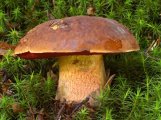Cadmium isotopic fractionation in mushrooms
Cadmium is a toxic metal occurring in 8 isotopes in nature. However, the ratios of these isotopes may vary slightly among individual environmental compartments. This is caused by a phenomenon called isotope fractionation, where one environmental compartment is enriched in a heavier or lighter isotope at the expense of another. This can be exemplified by the uptake of cadmium by plants whose leaves are often isotopically lighter than their cadmium source in the soil. A new paper published in the journal Science of the Total Environment investigated the isotopic composition of Cd in mushrooms and topsoils in western Bohemia. Compared to soils, many mushroom species show a distinctly lighter Cd isotopic composition and, as suggested by data, such isotope fractionation may depend on specific mushroom species.


